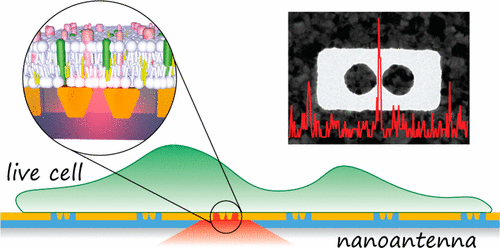Plasmonic nanoantennas investigate lipid rafts on living cell membranes
Plasmonic nanoantennas have a high potential to advance biological studies at the nanoscale. However, their use has been almost entirely focused on enhancing the fluorescence signal from individual molecules. In a recent Nano Letters paper entitled “Planar optical nano-antennas resolve cholesterol-dependent nanoscale heterogeneities in the plasma membrane of living cells”, we present the first report of optical nanoantenna arrays to study the diffusion dynamics of lipids in the membrane of living cells at the nanoscale. Our approach combines advanced nanofabrication routes with single molecule fluorescence studies using fluorescence burst analysis and fluorescence correlation spectroscopy.
Significance:
- We prove the existence of highly transient and fluctuating nanoscale assemblies of sterol and sphingolipids in living cell membranes. These nanodomains are cholesterol dependent and directly relate to the topic of lipid rafts, which has been heavily debated in the biological community for the last two decades.
- We establish a general methodology using nanoantennas to probe the architecture of live cell membranes with unprecedented spatial and temporal resolutions. This constitutes a major breakthrough in our ability to address the dynamics and interactions of molecules on the plasma membrane of living cells.
Access through Nano Letters webpage, also available on arXiv and Researchgate.

/image%2F1383851%2F20240412%2Fob_d06231_figtoc-aunc.jpg)
/image%2F1383851%2F20240410%2Fob_983d9d_s3ic-2024-banner-1920x380.png)
/image%2F1383851%2F20231116%2Fob_7c6f32_untitled16-figtoc.jpg)
/image%2F1383851%2F20231115%2Fob_6016e9_imagecombo.jpg)



